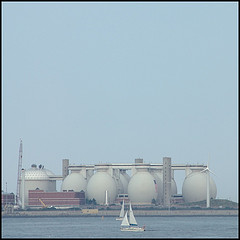- 5 reads

New research reveals that nitrous oxide, or N2O, is currently the top ozone-depleting substance emitted by humans. Nitrous oxide, commonly known as laughing gas, has effects on our ozone layer that might not be so funny, according to a new study by the National Oceanic & Atmospheric Administration.
Nitrous oxide breaks down when it reaches the stratosphere to form other gases that trigger ozone-destroying reactions. Nitrous oxide occurs naturally when bacteria in soil and ocean water break down nitrogen-containing compounds and release nitrous oxide; however, one third of the nitrous oxide in the atmosphere is attributable to human activities. It can be leaked into the atmosphere in ways as innocent as animal manure management, agricultural soil management, sewage treatment and combustion of fossil fuel. It is also used by dentists as a sedative.
Nitrous oxide is a greenhouse gas with heat-locking effects comparable to methane or carbon dioxide. The compound also acts as an ozone thinner and reform will be necessary in order to curb these dangerous effects on our atmosphere.
In past years, chlorofluorocarbons, or CFCs, dominated the focus of atmospheric discussion when scientists realized that the aerosols were eating a hole in the ozone layer. Now, nitrous oxide is poised to take center stage on the issue, as it is clear the chemical is thinning our atmosphere.
In 1987, the Montreal Protocol was established to control the production of CFCs and phase them out completely by 1996. The Earth’s ozone layer has benefited, but unregulated nitrous oxide emissions, which are not governed by the Montreal Protocol, is increasingly responsible for ozone depletion.
Nitrogen and chlorine act as counters to each other in terms of effects on the atmosphere. The unbalanced shift in levels of chlorofluorocarbons and nitrous oxide could, in fact, make the latter more potent. As chlorine compounds abate, the unchecked nitrous oxide becomes a more powerful agent of ozone depletion.
The 2009 U.S. Greenhouse Gas Inventory Report showed that nitrous oxide and methane were the largest ozone depleting gases emitted by agricultural activities. The largest source of nitrous oxide emissions in the U.S. has been linked to agricultural soil management activities. Cropping practices such as fertilizer application accounted for 67 percent of the emissions.
A potential solution may be found in the application of nitrification inhibitors (NIs) with ammonium-based fertilizers. Studies have shown that NIs such as dicyandiamide (DCD) and 3, 4-dimethyl pyrazole phosphate (DMPP) are effective management tools with which to mitigate nitrous oxide emissions from fertilization processes.A 2009 report by McKinsey & Co. illustrates solutions for curbing greenhouse gas emissions as a whole in the near future. According to the report, improving energy efficiency in buildings and appliances will have one of the largest impacts on the amount of emissions in the U.S. The report specifically referenced replacing traditional lighting fixtures in commercial buildings and residences with new LED lighting technology as one of the most cost effective ways to reduce our currently unsustainable environmental impact.
As our country moves towards more sustainable, clean energy, it is vital that we recognize nitrous oxide as an ozone-thinning chemical that needs immediate addressing. If we are uneducated on issues like nitrous oxide and continue to pollute, we may lose the only barrier protecting us from the harsh vacuum of space.

